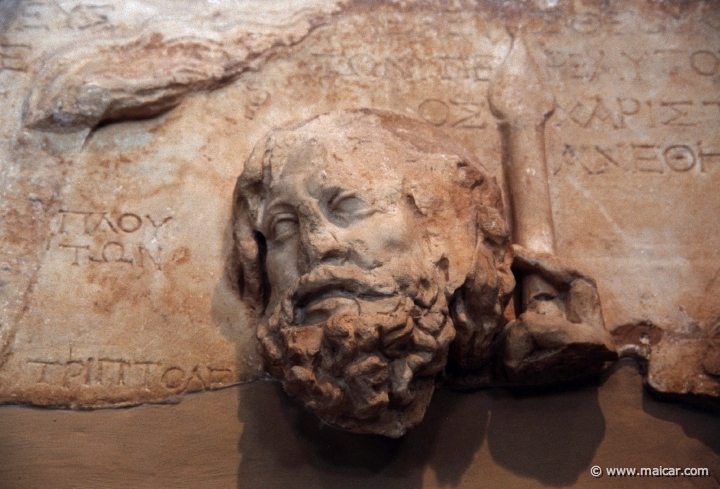|

|
6520: Hades. Relief dedicated by the priest Lakrateides and his family to the Eleusinian deities. It depicts the legend of Triptolemos 100-90 BC. Archaeological Museum of Eleusis.
|
|
"Hades is not to be soothed, neither overcome, wherefore he is most hated by mortals of all gods." (Agamemnon. Homer, Iliad 9.158).
|
|
Hades was allotted the dominion of the
Underworld and rules over the dead. This god is also known under several other names: Pluto 2, Aedoneus, Orcus and Dis. It is said that Hades was worshipped only in Elis.
Ruler of the
Underworld
Hades belongs to the first generation of
OLYMPIANS, being the
brother of Zeus,
Poseidon,
Hera,
Hestia, and
Demeter. After the war against the TITANS, the three brothers divided the world, and Hades was then allotted the dominion of the Underworld, whereas Poseidon rules the sea and Zeus the Heavens.
Hades possesses a helmet—which the CYCLOPES gave him (as they also gave the thunderbolt to Zeus and the trident to Poseidon)—that rends the wearer invisible. He sometimes lends it to both gods and men: for example, Perseus 1 put
the helmet on his head when he went to kill
Medusa 1, and
Hermes, wearing the
helmet, fought the
GIANTS. Later Athena, during the Trojan War, put on the helmet of Hades so that Ares should not see her (see Diomedes 2).
Abduction of Persephone
Hades carried off Demeter's daughter
Persephone, and because of her eating one (or several) seed of a pomegranate in the Underworld, she has to divide her time between the nether and the upper worlds. When Hades abducted her,
Demeter went about seeking her daughter all over the world, carrying torches by night and day. During her search she did not allow the earth to produce any fruits, and so Zeus ordered Hades to send back the girl. Hades obeyed, but gave Persephone a seed of a pomegranate to eat so that she shouldn't stay long with her mother. Not knowing about the effects of the seed, she swallowed it. And because Ascalaphus 2 bore witness against her, Demeter laid a heavy rock on him in the Underworld. But later Heracles 1 rolled away the stone of Ascalaphus 2, and then Demeter, still angry, turned Ascalaphus 2 into a short-eared owl.
Wounded by Heracles 1
It has been told that as Heracles 1 was campaigning against Pylos, Hades came to support the Pylians, and Heracles 1 wounded him with an arrow in the shoulder. Hades, they say, retired to Olympus where Paeeon, who in Heaven knows the remedies for all things, healed him.
|